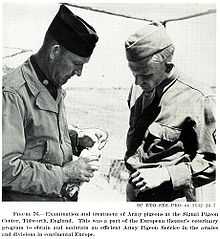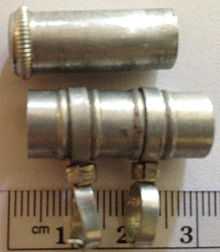United States Army Pigeon Service

The United States Army Pigeon Service (a.k.a. Signal Pigeon Corps) was a unit of the United States Army during World War I and World War II. Their assignment was the training and usage of homing pigeons for communication and reconnaissance purposes.[1]
During World War II, the force consisted of 3,150 soldiers and 54,000 war pigeons, which were considered an undetectable method of communication. Over 90% of US Army messages sent by pigeons were received.[2] The pigeon G.I. Joe received the Dickin Medal for gallantry that saved up to 1,000 lives.
From 1917–1943 and 1946–1957, the US Army Pigeon Breeding and Training Center was based at Fort Monmouth, N.J. From October 1943 until June 1946, the center was based at Camp Crowder.[3] The US Army discontinued using pigeons as message carriers in 1957. Fifteen "hero pigeons" were donated to zoos, and about a thousand other pigeons were sold to the public.[4]

References
- ↑ Levi, Wendell (1977). The Pigeon. Sumter, S.C.: Levi Publishing Co, Inc. ISBN 0-85390-013-2.
- ↑ U.S. Army Communications Electronics Museum. "Famous Pigeons".
- ↑ A Concise History of Fort Monmouth, New Jersey and the U. S. Army CECOM Life Cycle Management Command. 2009. p. 12.
- ↑ "Final Sale of Army Pigeons at Fort Monmouth - March 28th, 1957". Retrieved 8 April 2013.
External links
| ||||||||||||||||||||||